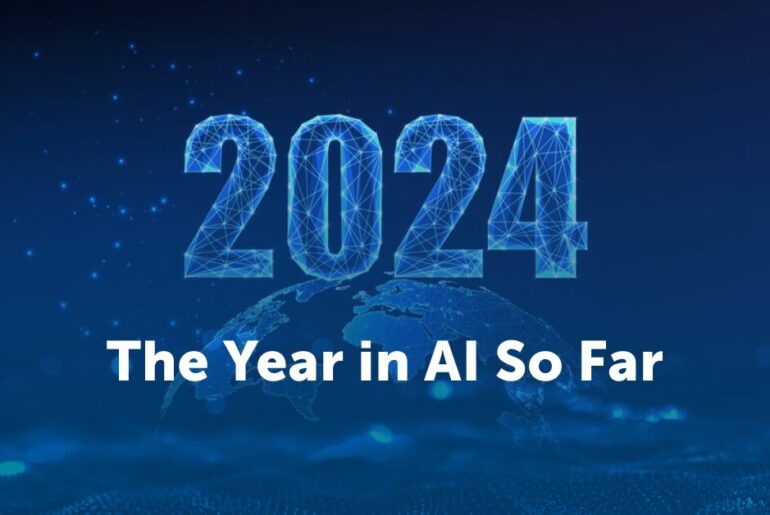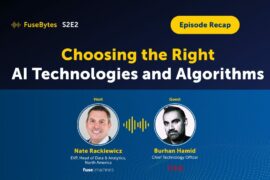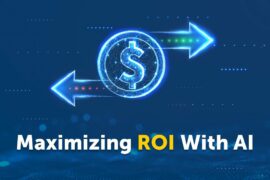As we approach the midpoint of 2024, it’s clear that artificial intelligence (AI) is continuing to drive profound technological and societal transformations. AI developments this year have drastically changed a number of industries, affecting international cooperation and competition. This blog examines the major discoveries in AI, their applicability in various industries, and the broader implications of these developments.
Significant Advances in AI
2024 has seen notable advancements in AI technology. The creation of incredibly lifelike text, photos, and videos using generative AI models has advanced, beyond the bounds of artistic expression and practical uses. The combination of AI and quantum computing has greatly accelerated processing rates and improved the capacity to tackle challenging issues.
Edge AI has become more popular, enabling data processing on local devices instead of centralized servers, improving real-time decision-making and lowering latency problems. Drones and other autonomous systems powered by AI have grown in popularity and dependability, especially in the logistics and transportation industries.
Here are some more notable AI advancements in 2024 so far–
1. Multimodal AI
- AI systems now integrate multiple types of data such as text, images, and speech.
- Examples include Google’s Gemini and OpenAI’s GPT-4, which allow more intuitive and comprehensive user interactions.
- Applications range from healthcare diagnostics to personalized marketing and customer service.
2. Model Optimization Techniques
- Techniques like Low Rank Adaptation (LoRA) and Quantization are reducing computational requirements.
- These methods make sophisticated AI capabilities more accessible to smaller players and startups.
- Enhanced model optimization is seen in fields like natural language processing and computer vision, where efficiency gains are critical.
3. API-driven AI and Microservices
- The proliferation of APIs simplifies the creation of AI-driven applications.
- These modular AI components can be integrated into existing systems to enhance functionalities such as customer service, inventory management, and personalized marketing.
- Companies are leveraging these APIs to create more flexible and scalable solutions. For example– IBM’s Watson, Google Cloud AI, Microsoft Azure Cognitive Services, and Twilio Autopilot offer AI services through APIs, providing tools for language processing, machine learning, data analysis, vision, speech, and conversational interfaces.
4. AI in Creative Arts and Entertainment
- AI is increasingly used in creative processes, including scriptwriting, music production, and art generation.
- AI tools assist artists and creators by providing new methods for artistic expression.
- Examples include Scriptbook, generating original music compositions with Amper Music and AIVA, and creating artistic images via Google’s DeepDream, showcasing AI’s transformative role in artistic expression.
5. Environmental Sustainability
- AI applications like Global Forest Watch by the World Resources Institute track deforestation, Climate AI predicts crop yields, and Carbon Tracker monitors greenhouse gas emissions using satellite data, showcasing AI’s role in addressing environmental challenges and promoting sustainability.
- AI is also used in smart grid management and renewable energy optimization.
- These applications demonstrate AI’s potential for positive environmental impact.

Explore how Fusemachines helps businesses transform with its AI Products and AI Solutions.
Schedule a complimentary consultation with an AI expert.
6. AI in Cybersecurity
- Advanced AI algorithms enhance threat detection and response capabilities.
- AI systems are deployed for real-time monitoring and predictive analysis to prevent cyberattacks.
- Darktrace specializes in Autonomous Threat Detection and Response (ATDR), employing AI for proactive defense in dynamic threat environments. Palo Alto Networks’ Prisma Cloud focuses on cloud-native threat prevention, crucial for secure cloud adoption. McAfee’s MVISION Cloud, enhanced by IBM’s X-Force Threat Intelligence, offers comprehensive AI-driven security, covering detection, response, and threat analysis for robust cybersecurity operations. These are some examples.
7. Ethical AI and Regulation
- There is a growing emphasis on ethical considerations and regulatory frameworks for AI.
- The EU AI Act of 2024 categorizes AI applications by risk, setting stringent rules for high-risk uses like facial recognition. The Global Forum on the Ethics of AI 2024 focused on fostering international cooperation and ethical standards in AI development.
- Companies are adopting AI ethics guidelines to ensure transparency, fairness, and accountability.
8. Personalized Education
- AI offers personalized learning experiences by adapting content to individual learning styles and backgrounds.
- AI in personalized education includes platforms like Carnegie Learning for AI-driven tutoring, Knewton’s adaptive learning tools, and Coursera’s personalized course recommendations, enhancing learning by tailoring content to individual needs and styles.
- AI helps in creating inclusive educational environments that cater to diverse student needs.
9. Precision Healthcare
- AI is advancing personalized treatment plans, diagnostics, and patient monitoring.
- Paige’s Lighthouse for mammogram analysis, Freenome’s disease risk prediction, IBM Watson Health and CVS Pharmacy’s personalized medicine, Babylon Health’s AI chatbots for patient support, and Intuitive Surgical’s da Vinci Xi for AI-driven robotic surgery, enhancing diagnostics, treatment, and patient care.
- These advancements improve the precision and efficiency of medical care, leading to better patient outcomes.
10. Virtual Agents
- AI-driven virtual agents are becoming more capable, moving beyond basic chatbots to perform complex tasks.
- Amelia (Hilton) and X (Marriott) assist hotel guests, BlueBot (KLM) handles flight queries, Sephora’s Beauty Advisor recommends products, and Erica (Bank of America) manages financial tasks, showcasing AI’s roles in hospitality, travel, retail, and finance sectors are some examples.
- These agents are integrated with various data streams to offer more personalized and efficient services.

Explore how Fusemachines helps businesses transform with its AI Products and AI Solutions.
Schedule a complimentary consultation with an AI expert.
The Global AI Landscape
The global landscape of artificial intelligence (AI) in 2024 is characterized by a dynamic interplay of cooperation and competition among leading nations and international organizations. Key players such as the United States, China, and European Union (EU) members are at the forefront of the race for AI supremacy. These nations have not only invested heavily in research and development but also in implementing AI technologies to gain technological superiority and economic advantages.
Cooperation also plays a pivotal role in this fiercely competitive environment. Recognizing the need for shared solutions to global challenges, international agencies and consortia have emerged to foster collaboration. These initiatives focus on resolving ethical dilemmas, exchanging knowledge, and establishing uniform regulatory frameworks. They are crucial not only for harmonizing AI practices across borders but also for addressing critical issues such as climate change and global health crises.
Cooperative Initiatives
Cooperation in AI extends beyond national boundaries to tackle pressing global issues. International collaborations leverage AI’s capabilities to develop solutions for climate monitoring, disaster response, and sustainable development. For instance, initiatives like the Paris Agreement have integrated AI to enhance climate modeling and support policy decisions.
In the realm of global health, AI-powered tools are pivotal in predicting disease outbreaks, accelerating drug discovery, and improving healthcare delivery. Organizations like the World Health Organization (WHO) collaborate with AI researchers to leverage data analytics and predictive modeling for early detection and response to health crises.
Ethical Frameworks and Standards
Ensuring ethical standards and regulatory frameworks becomes increasingly critical as AI technologies advance. The EU’s AI Act of 2024 exemplifies efforts to categorize and regulate AI applications based on their risk levels, particularly in sensitive areas such as facial recognition and autonomous vehicles. These regulations aim to safeguard privacy, promote transparency, and uphold accountability in AI deployment.
Bottom Line
The global AI landscape of 2024 reflects a dual narrative of competition and cooperation. While nations vie for leadership in AI technology, international partnerships are essential for navigating ethical complexities and harnessing AI’s transformative potential on a global scale. Future developments in AI are expected to bring about even more profound shifts, forming a society in which AI is a vital part of our everyday existence.

Explore how Fusemachines helps businesses transform with its AI Products and AI Solutions.
Schedule a complimentary consultation with an AI expert.






